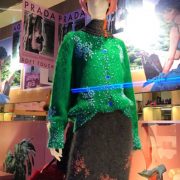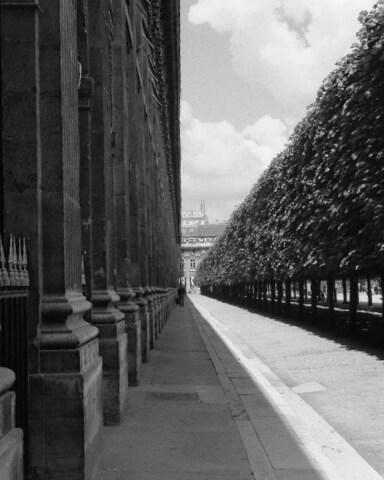THE NIGHTMARE OF ITS DESIGNER ONLY A FEW
The Irish-Scottish designer Eileen Gray only received recognition late in her life. This was also due to the fact that friends were envious of her talent and did not begrudge her her fame.
“Good furniture is like good friends”
Says ClassiCon, the only company in the world to hold the license to produce Eileen Gray’s furniture designs.
Many of these pieces of furniture are familiar to us. The glass table that Eileen Gray developed for her house E.1027 in the south of France can now be found in many rooms where style is at home.
It goes with any style of furnishing. It looks good without drawing all the attention to itself. Eileen Gray designed the table for her sister, who was often a guest in her house E.1027 and loved to have breakfast in bed. The table can be easily slid over a bed or couch thanks to its opening in the standing area. The originals of the table can also be adjusted in height.
 E.1027 in Roquebrune-Cap-Martin © Alamy Stock Photo, 2024
E.1027 in Roquebrune-Cap-Martin © Alamy Stock Photo, 2024
E.1027 – a house like a ship
In 1929, Eileen Gray built a house on the Côte d’Azur for herself and her friend, the architect and architecture critic Jean Badovici. The name of the house E.1027 stands for the names of the two of them: E. for Eileen, 10 (the 10th letter in the alphabet) for the J in Jean, 2 for Badovici and 7 for Gray.
The house is nestled on a cliff above the sea. With its elongated shape along the cliff, the long veranda and the many windows, which all offer a view of the Mediterranean, it looks like a ship’s railing. Some of the round windows inside the house are reminiscent of portholes.
We can all understand Eileen Gray’s desire to find peace and quiet in this house and enjoy the sea.
 Eileen Gray, 1910 © Alamy Stock Photo
Eileen Gray, 1910 © Alamy Stock Photo
Her boyfriend Jean Badovici had a different idea: one visit after another turned the quiet, stylish house into a party location. The quiet oasis with white walls and minimalist furniture, which Eileen Gray had designed for summers of beautiful togetherness with a view of the sea, became a chaos of overflowing ashtrays and empty wine bottles. On the fantastic long veranda, where white, grey and the blue sea played the leading role, the guests’ colorful bath towels now fluttered to dry.
The fatal friend
Eileen Gray left her dream house and went to Paris. Jean Badovici invited their mutual friend Le Corbusier. The later world-famous architect immediately recognized the architectural jewel that Eileen Gray had created.
He began to cover the white interior and exterior walls with huge colorful frescoes. Jean Badovici had agreed to this and Le Corbusier had himself proudly photographed painting the walls, even without too much clothing.
Could he not bear the fact that a woman who was one of the first women to study design at the Stade School of Art in London had created the perfect house by the sea?
When he was later sometimes mistaken for the architect of house E.1027, he did not contradict this. He died on August 27, 1965 while bathing in the sea, within sight of E.1027. He had a wooden house with colorful paintings built directly behind the house E.1027.
E.1027
Eileen Gray described the blatant painting of her white dream as vandalism and demanded that the painting be reversed. To no avail.
In the end, their vision triumphed. The house stood empty for many years and began to decay in the humid sea climate. However, it was not demolished, as the frescoes by Le Corbusier, who had since achieved great fame, were not to be destroyed.
The municipality of Roquebrune-Cap-Martin finally acquired the house and after long discussions about which artistic heritage should be preserved, it was largely restored to the state that Eileen Gray had created. Some of the frescoes by Le Corbusier were preserved.
E.1027 is now a museum that can be visited by appointment in small groups with a guide from October to May.
The visitor ticket includes a visit to Le Corbusier’s small, brightly colored wooden house, which he built for himself directly behind E.1027.
The contrast between two houses could not be greater.
The movie
Swiss director Beatrice Minger has produced a film about Eileen Gray and her house: “E.1027 – Eileen Gray and the House by the Sea”. The film was released in the fine but small arthouse cinemas in Germany at the end of October 2024 and we suspect only a few people have seen it.
It’s a shame, because the film tells the story of the house with hauntingly beautiful images at the original locations and with a very convincing leading actress, Natalie Radmall-Quirke, as Eileen Gray.
Le Monde says: “Poetry glides through every shot, every angle, every sound”.
You can watch this movie at Mubi.

Your furniture lives on
Eileen Gray designed the famous glass table and numerous other pieces of furniture for E.1027. This furniture has a stunning simplicity. They often work with folding or sliding mechanisms to make optimum use of the space in the relatively small house.
 E.1027 Eileen Gray (Natalie Radmall-Quirke) and the house by the sea © RASC, Rise and Shine Cinema
E.1027 Eileen Gray (Natalie Radmall-Quirke) and the house by the sea © RASC, Rise and Shine Cinema
The designer Zeev Aram recognized the special nature of these furniture designs by Eileen Gray. Most of them were one-off pieces that she had designed and built for her houses and apartments and with which she felt comfortable. The furniture pieces were sometimes shown in design exhibitions and some were produced in small series.
Yves St. Laurent acquired the unique piece of the “Dragon Armchair” by Eileen Gray. A design that she had worked on for two years. When the art collection of Yves Saint Laurent and his partner Pierre Bergé was auctioned off at Christies in Paris in 2009 after his death, the dragon armchair fetched a record price of 22 million euros.
Zeev Aram, who had founded a furniture store in London, visited Eileen Gray, who was 95 years old at the time, in her Paris apartment and received a worldwide license from her to market and produce her furniture designs.
A stroke of genius by Zeev Aram, who brought modern furniture design to England at a time when people still preferred to buy replicas of Regency furniture. When he opened his furniture store in London Chelsea in 1964, he sold a chair and had to wait seven months before the next customer decided to buy it.
His grandson now runs the furniture store at 110 Drury Land, Covent Garden, London. We have already spent a few hours there, because you are surrounded by timelessly beautiful pieces of furniture. You can also see the lacquered screens that Eileen Gray started with, the lamp she designed, the daybed, the sofa and the small cupboards.
Zeev Aram Design in turn granted a worldwide license to produce Eileen Gray’s furniture to the German company ClassiCon. If you are not planning a visit to London, you can also visit the ClassiCon showroom in Munich.
Eileen Gray’s designs look as beautiful today as if they were designed only yesterday. Yet the designer was born in 1887 on the family estate of Brownswood in County Wexford, Ireland.
Good friends stay for life.
Cover picture Eileen Gray glass table © GloriousMe 2025



